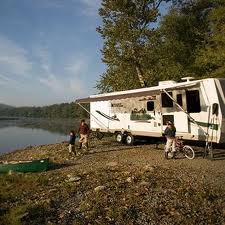Can you live in an RV full time?
Those who dream of living year-round in an RV might find it’s easier than they’d imagined. Here’s how to hit the road in a permanent home on wheels.
Have you ever thought about chucking it all and taking to the road full time? Well you can, you could join some 1.3 million Americans who are full-time RV’ers.
To find out what it takes to afford becoming a full-timer, “living the RV dream” (Podcasts are available here.) . “Talk Credit Radio.” Here are the Huggins’ financial tips for a life on the road.
Get organized
 While you’re traveling, you’ll need to have someone receive and forward your mail to you. That could be a friend, relative or a mail service. The Huggins use a mail service located in South Dakota (more on that choice later) that forwards their mail twice a month.
While you’re traveling, you’ll need to have someone receive and forward your mail to you. That could be a friend, relative or a mail service. The Huggins use a mail service located in South Dakota (more on that choice later) that forwards their mail twice a month.
They also rely on online banking and bill pay. Their phone, credit card and satellite dish bills are all paid online. If there is a bill that can’t be handled that way (“a hospital bill, for example,” says Kathy), “I leave them a note that I only get my mail twice a month, that I may be late and please do not charge me (a late fee),” she explains. She’s never had a problem, she adds.
 What to look for when buying an RV
What to look for when buying an RV
For banking, they use direct deposit and a debit card. To avoid ATM fees, they chose a bank that refunds ATM fees and often get cash back at the cash register when they make a purchase on their debit cards.
Have a (flexible) budget
Does living in an RV cost less, or more, than living in a traditional home? For the Huggins, it’s less. Kathy rattled off her monthly expenses: rig payment, phone bill and satellite television, for starters. Campsite fees can range from free to $60 to $70 per night, though she says they try to keep theirs at $20 per night.
To keep your electric bill down, avoid staying in one place for months, because long-term campers usually have to pay for their own electricity.
“Stay for less than a month, and they pay the electric bill,” she says. Even when the Huggins do pay for electricity, it’s pretty inexpensive: about $40 per month, or $80 a month if it’s cold and the electric heaters go on.
“Remember, we’re living in 400 square feet,” she adds with a laugh.
And while many campsites have free Wi-Fi available, the Huggins spring for their own wireless Internet connection because they need Internet access for their website and blog.
Cooking their own food and limiting meals in restaurants also saves them a bundle.
As with any budget, there are always surprises. For the Huggins, it’s been rising gas prices, which went from $2.99 a gallon to almost $4 a gallon at the time we spoke. “That’s been a big change in our lifestyle,” Kathy says, “but we just spend more time in a campsite. We’ll travel maybe 250 miles a day at the most, and we might stay (in one place) three or four weeks. We use our car, which we tow, to go see all the things that are around here.”
 Save up for your rig, shop for the loan
Save up for your rig, shop for the loan
Kathy was asked what it costs to buy an RV that would be comfortable to live in year-round. She says a used motor home will run “right around $100,000 if it’s a diesel pusher and about $80,000 for a gas rig. And they’re pretty comfortable.” The other option is to buy a “fifth wheel” that is pulled by a truck. “You’re talking about $40,000 to $60,000,” she says, but “then you have to buy a truck to pull it, which can be up to $40,000 for the truck.”
Before hitting the road, the Huggins sold their Florida home at the height of the market, which allowed them to get rid of all their debt and put a healthy down payment on their rig. Still, they took out a 20-year loan at 4.35% for the balance. That was a few years ago, though, and since then, full-time RV’ers have found it more difficult to get loans.
“Try a credit union,” suggests Kathy. Or buy your rig before you quit your job. “If you’re going to be a part-timer, they don’t seem to have a problem giving you a loan,” she notes.
Get a tax break
One of the advantages of living on the road is that you can call any state home.
The Huggins, like many other full-timers, chose South Dakota as their home base because of the tax benefits. There is no state income tax and, as Huggins points out, no property tax since they don’t own a home. “South Dakota probably has half a million people that don’t live there but are full-time RV’ers because of taxes,” she says, laughing. Tax rates and other details are available in the book “Choosing Your RV Home Base.”
You don’t have to stop working when you start traveling. Many RV parks hire full-time RV’ers to handle reservations or park maintenance. Kathy was working as a reservationist while her husband was doing pool maintenance, which earned them a free site and an allowance of $100 a month toward their electric bill, plus enough spending money to cover their food budget.
Around Yellowstone, she notes, you can work at a hotel and have a parking spot for your RV while employed there. “Even Alaska has jobs for you,” she says. “You (can) guard the schools during the summer. Park your RV in the schoolyard with two or three other RV’ers, and you just keep an eye for the schoolyard, and that’s it,” she says. She recommends the website Workamper.com for employment opportunities.
Entrepreneurial opportunities abound as well and are limited only by your imagination. A couple that Kathy suggested: Watch other full-timers’ pets while they fly home for holidays or take day trips. Or make jewelry to sell.
Do you have to be out of debt to take to the road? It helps, says Kathy. But even if you aren’t, you may still want to find a way to make it happen.
“I think almost anybody can do it,” she says. “The cost can range from $200 a month to $12,000 a month, depending on what you want to do and how you want to spend your money. That’s the best part about this — it’s your choice about . . . how big of a rig you actually buy, how much money you want to spend.”
The Huggins’ only regret? That they didn’t do it earlier. ‘”Most full-time RV’ers, said the same thing: ‘I wish I’d done it 10 years sooner.'”
Barbara Andrews.


















